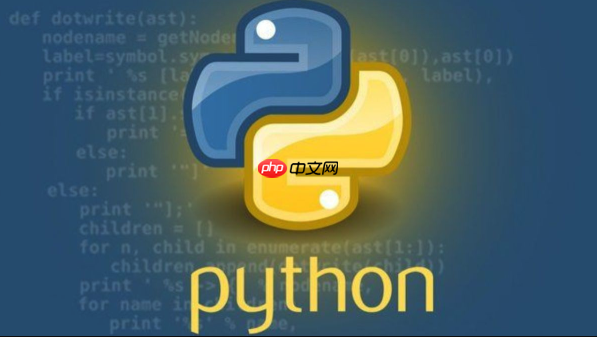如何使用functools.singledispatch處理不同異常類型?1. 使用@functools.singledispatch裝飾主異常處理函數(shù),定義默認處理邏輯;2. 通過@register方法為每個具體異常類型(如valueerror、typeerror、filenotfounderror)注冊專屬處理函數(shù);3. 在異常發(fā)生時自動匹配最具體的處理函數(shù),支持繼承關系的異常類型優(yōu)先調(diào)用子類處理邏輯;4. 可結合Logging模塊按異常類型進行不同級別的日志記錄,提升代碼可維護性與可讀性。

functools.singledispatch 允許你基于函數(shù)的第一個參數(shù)的類型,來定義不同的函數(shù)實現(xiàn)。這可以用來為不同的異常類型提供定制的處理邏輯,讓你的代碼更具可讀性和可維護性。

處理不同異常類型,就是針對不同異常的“形態(tài)”做出反應,singledispatch正好擅長這個。

解決方案:
import functools @functools.singledispatch def handle_exception(exception): """ 默認的異常處理邏輯。 """ print(f"Unhandled exception: {type(exception).__name__} - {exception}") @handle_exception.register def _(exception: ValueError): """ 處理 ValueError 異常的邏輯。 """ print(f"ValueError occurred: {exception}. Let's try something else...") # 在這里添加特定于 ValueError 的處理代碼 @handle_exception.register def _(exception: TypeError): """ 處理 TypeError 異常的邏輯。 """ print(f"TypeError occurred: {exception}. Maybe check your types?") # 在這里添加特定于 TypeError 的處理代碼 @handle_exception.register def _(exception: FileNotFoundError): """ 處理 FileNotFoundError 異常的邏輯。 """ print(f"FileNotFoundError: {exception}. Double check that path!") # 在這里添加特定于 FileNotFoundError 的處理代碼 # 示例用法 try: raise ValueError("Invalid value") except Exception as e: handle_exception(e) try: raise TypeError("Incorrect type") except Exception as e: handle_exception(e) try: raise FileNotFoundError("File not found") except Exception as e: handle_exception(e) try: raise Exception("Generic exception") except Exception as e: handle_exception(e)
這種方式避免了大量的 if/elif/else 結構,代碼更清晰。

如何處理繼承關系的異常類型?
如果你的異常類型存在繼承關系,singledispatch 會選擇最具體的注冊函數(shù)。例如,如果 MyCustomError 繼承自 ValueError,并且你同時注冊了 ValueError 和 MyCustomError 的處理函數(shù),那么當拋出 MyCustomError 異常時,會調(diào)用 MyCustomError 的處理函數(shù)。如果沒有 MyCustomError 的處理函數(shù),則會調(diào)用 ValueError 的處理函數(shù)。
class MyCustomError(ValueError): pass @handle_exception.register def _(exception: MyCustomError): print("Handling MyCustomError specifically!") try: raise MyCustomError("This is a custom error") except Exception as e: handle_exception(e)
這種行為是符合預期的,但需要注意,確保你的異常處理邏輯覆蓋了所有可能的情況。
使用 singledispatch 處理異常的性能考量
singledispatch 在首次調(diào)用時會進行一些類型檢查和函數(shù)注冊,這可能會帶來一些性能開銷。但是,一旦注冊完成,后續(xù)的調(diào)用將會非常快,因為它使用了緩存機制。
如果你的異常處理邏輯需要非常高的性能,可以考慮使用其他方法,例如直接使用 if/elif/else 結構。但是,對于大多數(shù)應用場景來說,singledispatch 的性能足夠好,并且可以帶來更好的代碼可讀性和可維護性。
更進一步,可以考慮結合日志記錄。
import logging logging.basicConfig(level=logging.ERROR) # 設置日志級別 @functools.singledispatch def handle_exception(exception): logging.error(f"Unhandled exception: {type(exception).__name__} - {exception}") @handle_exception.register def _(exception: ValueError): logging.warning(f"ValueError occurred: {exception}. Trying something else...") # 特定于 ValueError 的處理代碼 @handle_exception.register def _(exception: FileNotFoundError): logging.critical(f"FileNotFoundError: {exception}. Double check that path!") # 特定于 FileNotFoundError 的處理代碼
這樣,未處理的異常會被記錄為錯誤,ValueError 記錄為警告,F(xiàn)ileNotFoundError 記錄為嚴重錯誤,可以根據(jù)異常的嚴重程度進行不同的日志記錄。



















